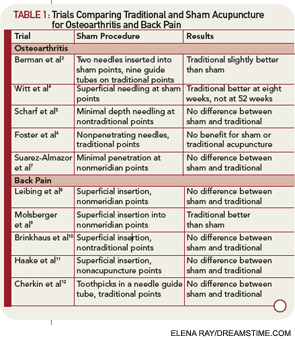Rheumatologists provide care for many patients with musculoskeletal pain and osteoarthritis (OA). Patients with these conditions accounted for 33.5% of visits to alternative therapists in 2007.1 Many of these visits were for acupuncture treatments to relieve pain. A National Health Statistics Report estimated that in 2007, there were 17,629 visits to acupuncturists at an out-of-pocket cost of more than $827 million.2 What benefits are patients receiving for their money?
This article will summarize the results of recent clinical trials of acupuncture for pain, discuss whether acupuncture analgesia is mediated by placebo effects, and consider how rheumatologists should advise patients about the use of acupuncture for relief of pain.
Clinical Trials
In traditional Chinese acupuncture (TCA), needles are inserted at specified points along meridians (see Figures 1 and 2), channels through which vital energy or qi is believed to flow. Specified groups of points are used to treat different disease conditions. Many older clinical trials reported that TCA provided more relief than usual treatment alone for musculoskeletal pain and OA. However, usual treatment alone is not an adequate control for the acupuncture procedure, and recent trials compared TCA with sham acupuncture procedures, in addition to usual treatment alone.
Table 1 lists trials that compared TCA, sham acupuncture, and usual treatment alone for knee OA and low back pain.3-12 A variety of sham procedures were used, including traditional and nontraditional acupuncture points, noninsertion or superficial insertion of needles, and contacting skin with a toothpick in a needle guide tube. Nine of the 10 trials found that TCA and sham treatments were more effective than usual care without acupuncture. One study found no benefit from the addition of TCA or sham acupuncture as an adjunct to exercise-based physiotherapy.6
A National Health Statistics Report estimated that in 2007 there were 17,629 visits to acupuncturists at an out-of-pocket cost of more than $827 million.
Two OA trials reported that the sham treatment was as effective as TCA.5,7 Berman et al reported that TCA was more effective than sham acupuncture.3 However, the same group concluded in a later review that the difference between TCA and sham acupuncture in their trial and others was small and clinically irrelevant.13 Witt et al observed that TCA was more effective than the sham procedure at eight weeks but not at 52 weeks.4 Four of the five back-pain studies found that TCA and sham acupuncture were equally effective.8,10-12 Data illustrating the equal efficacy of traditional and sham acupuncture for back pain are presented in Figure 3.12 Molsberger et al reported that TCA was more effective than sham acupuncture.9
Madsen et al performed a systematic review of trials of TCA and sham acupuncture for pain.14 The 13 trials they analyzed included five of the trials listed in Table 1 and other trials for headache, postoperative pain, and other conditions. They noted a small difference in efficacy between TCA and sham acupuncture, a moderate difference between sham and no acupuncture, and no association between the type of sham acupuncture and efficacy. There was substantial heterogeneity in the comparison of sham acupuncture with no acupuncture. Sham acupuncture was much more effective than usual care in some trials and no better in others. They concluded that the analgesic effect of acupuncture was small and seemed to lack clinical relevance, and that, “Whether needling at acupuncture points, or at any site, reduces pain independently of the psychological impact of the treatment ritual is unclear.”


